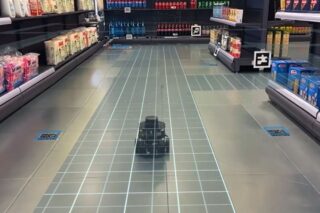Your shopping habits are about to change! New trends are shaking up the retail sector. From hands-free voice commerce from home to pop-up stores, discover how you will shop in the future.
Amazon’s net sales reached $72.4 billion in the fourth quarter of 2018, compared to $60.5 billion for the same period in 2017. Part of these impressive results come from Alexa, their automated voice service offered to consumers via their Echo smart speakers.
Amazon doesn’t just sell Alexa. It sells through Alexa. By 2020, Alexa will drive $10 billion in sales, according to research from RBC Capital Markets. 40% of people who own Alexa devices shop more with Amazon.
Conversational Commerce
For research consultancy firm Capgemini, the trend toward hands-free conversational commerce, taking place as the consumer flits between daily tasks, will transform retail. Their survey showed that 35% of voice-assistant users have bought products such as groceries and clothes using Alexa or similar services. Over three years, Capgemini expects shoppers’ voice-assisted spending to increase by 500%.
For Mark Taylor, expert in customer experience practice at Capgemini,
Voice assistants will completely revolutionize how brands and consumers interact with each other. They are woven into the fabric of our lives, offering a simplicity and richness of interaction that consumers have never experienced before.
My Personal Shopper
The top 1% of a retailer’s customers are worth 18 times more than the average customer, according to RJMetrics. Selling more effectively to them means retailers can improve their profit margins and growth. A stream of interaction data in sales, combined with demographic segmentation, website interactions and social media feeds can help retailers understand their customers and sell more, explains Kathy Kirk, managing principal at consulting company EPAM.
Retailers must leverage big data and artificial intelligence to develop deeper business and customer insights. AI tools incorporate data in real-time and apply collaborative filtering, feature-based algorithms and contextual learning to make predictions and recommendations around customer behavior to help them throughout their buying journeys.
AR Puts Consumers in the Picture
While virtual reality requires users to wear obtrusive headsets, with augmented reality you only need a smartphone to add a digital layer onto the real world. As such, it appeals to retailers who are building applications harnessing its power to help customers navigate stores and learn more about products.
A survey by research firm Retail Perceptions showed 61% of shoppers prefer to shop at stores that offer AR. Genesys has worked with the UK’s Coventry University to demonstrate how AR can guide shoppers through stores and offer information about items. For Simon Wright, head of VR and AR,
AR will have different applications in the home and in store. For example, consumers could use AR to install a set-top box: remote agents can ‘draw on’ the AR to point to details customers have overlooked.
Pop-Up Stores
Retailers with physical stores are responding to the threat of e-commerce and voice-assisted purchases. Commentators say stores will become places for events, as much as for selling. For example, Evans Cycles in the UK hosts “Ride It” events in which customers take part in bike rides beginning and ending at a store.
In Asia, the arrival of mobile point of sale devices has heralded a trend in pop-up stores, which retailers can set up at short notice to capture the public’s imagination. Storefront, an online marketplace for renting short-term retail space, estimates that by 2020 over 3,000 pop-up stores will be launched in China.
Solving the Logistics Puzzle
The combination of e-commerce, voice commerce and click-and-collect creates headaches for retail logistics. The large internet retailers have created an unquenchable demand for next-day and even same-day delivery, while free returns have also become the norm. Keeping up with these trends is economically unsustainable without exploiting the latest technologies to overhaul retail logistics according to Emile Naus, operations director with consultancy firm BearingPoint:
One answer is to use stores as mini-warehouses to supply online orders close to the customer. But most retailers do not have sufficiently accurate inventory control in stores. Machine learning could help anticipate demand for online orders and hold stock nearer customers before they order it.
This approach might work for fast-moving consumer goods, such as laundry detergent, but will be difficult to execute for less frequently-bought categories including clothing.










